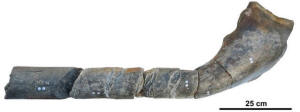|
Jaw fossil from English beach belongs to
monstrous marine reptile
 Send a link to a friend
Send a link to a friend
 [April 10, 2018]
By Will Dunham [April 10, 2018]
By Will Dunham
WASHINGTON (Reuters) - A jawbone fossil
found on a rocky English beach belongs to one of the biggest marine
animals on record, a type of seagoing reptile called an ichthyosaur that
scientists estimated at up to 85 feet (26 meters) long - approaching the
size of a blue whale.
Scientists said on Monday this ichthyosaur, which appears to be the
largest marine reptile ever discovered, lived 205 million years ago at
the end of the Triassic Period, dominating the oceans just as dinosaurs
were becoming the undisputed masters on land. The bone, called a
surangular, was part of its lower jaw.

The researchers estimated the animal's length by comparing this
surangular to the same bone in the largest ichthyosaur skeleton ever
found, a species called Shonisaurus sikanniensis from British Columbia
that was 69 feet (21 meters) long. The newly discovered bone was 25
percent larger.
"This bone belonged to a giant," said University of Manchester
paleontologist Dean Lomax.
"The entire carcass was probably very similar to a whale fall in which a
dead whale drops to the bottom of the sea floor, where an entire
ecosystem of animals feeds on the carcass for a very long time. After
that, bones become separated, and we suspect that's what happened to our
isolated bone."
Fossil collector Paul de la Salle, affiliated with the Etches Collection
in Dorset, England, found the bone in 2016 at Lilstock on England's
Somerset coast along the Bristol Channel.
"The structure was in the form of growth rings, like that of a tree, and
I'd seen something similar before in the jaws of late Jurassic
ichthyosaurs," he said.
[to top of second column]
|

The jaw bone of a giant ichthyosaur found on an English beach is
pictured in this undated handout photo obtained by Reuters April 9,
2018. Dean Lomax, The University of Manchester/Handout via REUTERS

Ichthyosaurs swam the world's oceans from 250 million years ago to
90 million years ago, preying on squid and fish. The biggest were
larger than other huge marine reptiles of the dinosaur age like
pliosaurs and mosasaurs. Only today's filter-feeding baleen whales
are larger. The blue whale, up to about 98 feet (30 meters) long, is
the biggest animal alive today and the biggest marine animal ever.
The researchers estimated the new ichthyosaur at 66 to 85 feet long
(20 to 26 meters).
It appears to have belonged to an ichthyosaur group called
shastasaurids. Because the remains are so incomplete, it is unclear
whether it represents a new ichthyosaur genus or is a member of a
previously identified genus, said paleontologist Judy Massare of the
State University of New York College at Brockport.
The research was published in the journal PLOS ONE.
(Reporting by Will Dunham; Editing by Sandra Maler)
[© 2018 Thomson Reuters. All rights
reserved.]
Copyright 2018 Reuters. All rights reserved. This material may not be published,
broadcast, rewritten or redistributed.
Thompson Reuters is solely responsible for this content.

 |